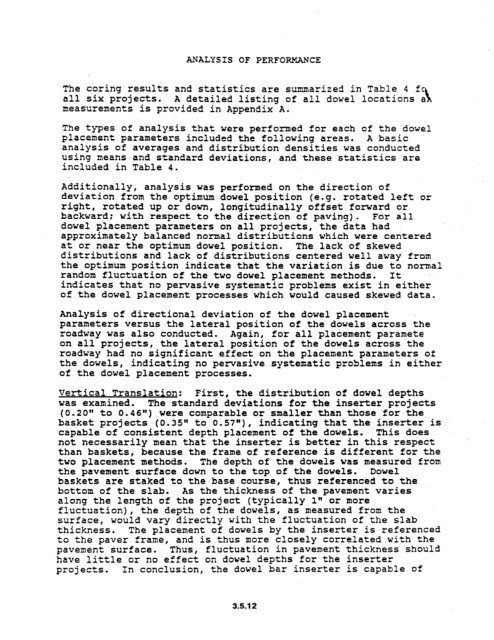chapter 3 rigid pavement - DOT On-Line Publications - Department ...
chapter 3 rigid pavement - DOT On-Line Publications - Department ...
chapter 3 rigid pavement - DOT On-Line Publications - Department ...
You also want an ePaper? Increase the reach of your titles
YUMPU automatically turns print PDFs into web optimized ePapers that Google loves.
ANALYSIS OF PERFORMANCE<br />
The coring results and statistics are summarized in Table 4 fc<br />
all six projects. A detailed listing of all dowel locations a 1<br />
measurements is provided in Appendix A.<br />
The types of analysis that were performed for each of the dowel<br />
placement parameters included the following areas. A basic<br />
analysis of averages and distribution densities was conducted<br />
using means and standard deviations, and these statistics are<br />
included in Table 4.<br />
Additionally, analysis was performed on the direction of<br />
deviation from the optimum dowel position (e.g. rotated left or<br />
right, rotated up or down, longitudinally offset forward or<br />
backward: with respect to the direction of paving). For all<br />
dowel placement parameters on all.projects, the data had<br />
approximately balanced normal distributions which were centered<br />
at or near the optimum dowel position. The lack of skewed<br />
distributions and lack of distributions centered well away from<br />
the optimum position indicate that the variation is due to normal<br />
random fluctuation of the two dowel placement methods. It<br />
indicates that no pervasive systematic problems exist in either<br />
of the dowel placement processes which would caused skewed data.<br />
Analysis of directional deviation of the dowel placement<br />
parameters versus the lateral position of the dowels across the<br />
roadway was also conducted. Again, for all placement paramete<br />
on all projects, the lateral position of the dowels across the<br />
roadway had no significant effect on the placement parameters of<br />
the dowels, indicating no pervasive systematic problems in either<br />
of the dowel placement processes.<br />
Vertical Translation: First, the distribution of dowel depths<br />
was examined. The standard deviations for the inserter projects<br />
(0.20" to 0.46") were comparable or smaller than those for the<br />
basket projects (0.35" to 0.57"), indicating that the inserter is<br />
capable of consistent depth placement of the dowels. This does<br />
not necessarily mean that the inserter is better in this respect<br />
than baskets, because the frame of reference is different for the<br />
two placement methods. The depth of the dowels was measured from<br />
the <strong>pavement</strong> surface down to the top of the dowels. Dowel<br />
baskets are staked to the base course, thus referenced to the<br />
bottom of the slab. As the thickness of the <strong>pavement</strong> varies<br />
along the length of the project (typically 1" or more<br />
fluctuation), the depth of the dowels, as measured from the<br />
surface, would vary directly with the fluctuation of the slab<br />
thickness. The placement of dowels by the inserter is referenced<br />
to the paver frame, and is thus more closely correlated with the<br />
<strong>pavement</strong> surface. Thus, fluctuation in <strong>pavement</strong> thickness should<br />
have little or no effect on dowel depths for the inserter<br />
projects. In conclusion, the dowel bar inserter is capable of<br />
3.512
















